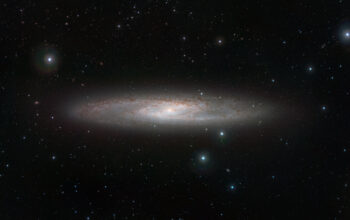In the vast, mesmerizing tapestry of the cosmos, various phenomena provide crucial insights into the historical and ongoing events that have shaped our universe. Among these celestial instruments, carbonaceous materials serve as phenomenal barometers, allowing scientists to gauge the climatic and chemical evolution of cosmic environments. This exploration into the role of carbonaceous materials as cosmic barometers promises not only to shift our understanding but also invites fervent curiosity about the intricate relationships between these elements and the historical narrative of the universe.
Carbon, one of the quintessential building blocks of life, exists in an assortment of forms across the cosmos—ranging from simple hydrocarbons to complex organic molecules. These carbonaceous materials are ubiquitous; meteorites, interstellar dust grains, and even comets are laden with them. Their presence in various astrophysical settings is not merely incidental; rather, it embodies a story of the universe’s evolution, encapsulating pivotal epochs from the formation of stars to the birth of planetary systems.
This article aims to delve into how carbonaceous cosmic barometers help unveil the enigmatic weather history of the universe. We will investigate the formation processes of carbon-rich materials, their environmental significance, and what revelations about cosmic weather patterns they can potentially unlock.
The Genesis of Carbonaceous Compounds
The creation of carbon-bearing materials typically occurs in the high-energy environments of star formation and supernova explosions. During these cataclysmic events, stellar nucleosynthesis processes forge heavier elements from lighter ones. Carbon isotopes, particularly carbon-12 and carbon-13, emerge as byproducts, enriching the surrounding interstellar medium. Following the death of stars, these elements become part of planetary nebulas, eventually forming the building blocks for future generations of celestial bodies.
In regions such as star-forming clouds, prevalent carbonaceous dust grains coalesce. These grains facilitate the accretion processes that contribute to the birth of new stars and planetary systems. Furthermore, the intricate chemical reactions occurring within these grains hint at the complex environmental conditions shaping early developing planets. By analyzing these carbonaceous materials, astrophysicists can infer the thermal and chemical history of star-forming regions, leading to a more profound understanding of our universe’s evolution.
Carbonaceous Materials: A Window to the Chemical Evolution
Beyond their role in metallic composition, carbon-bearing compounds serve as vital indicators of chemical evolution across the cosmos. The types of carbonaceous materials present in meteorites and comets can reflect the conditions present during their formation. For instance, the presence of polycyclic aromatic hydrocarbons (PAHs) points to high-temperature environments, whereas a predilection for simple hydrocarbons indicates colder, more primordial conditions.
Furthermore, the isotopic compositions of carbon can shed light on biological activity in the cosmos. The ratio of carbon-12 to carbon-13 can serve as a biosignature, which scientists might employ in the search for extraterrestrial life. By studying carbonaceous materials, researchers can chart a timeline of how the building blocks of life have proliferated across the universe.
Detecting the Cosmic Weather
The methodology for leveraging carbonaceous materials as barometers involves sophisticated techniques. Spectroscopic analyses, for example, allow for the identification of various carbon-rich compounds in meteorites and astronomical bodies. Additionally, in situ analyses performed by spacecraft can reveal elemental compositions in celestial bodies, giving astronomers a more nuanced understanding of their chemical environments.
Old meteorites, such as the Murchison meteorite, have served as exemplary samples, revealing a cornucopia of organic material. This meteorite showcases a plethora of amino acids and other organic compounds formed in extreme cosmic conditions. These findings amplify the tantalizing possibility that the ingredients for life on Earth may have originated from extraterrestrial sources.
Moreover, data from telescopes probing the cosmic microwave background radiation yield additional information regarding the cosmic weather. Fluctuations in this radiation can reflect the distribution of matter in the early universe, which, when paired with the findings from carbonaceous materials, creates a more detailed picture of the universe’s formative years.
The Future of Cosmic Barometers
As spacecraft technology and analytical methodologies improve, the prospect of revealing more intricate details about the universe’s climatic history becomes increasingly tangible. Upcoming missions, such as the Mars Sample Return, aim to collect materials that may harbor carbonaceous compounds, shedding light on potential biosignatures that exist beyond our planet.
Furthermore, advancements in laboratory techniques allow for the simulation of cosmic conditions under which carbonaceous materials evolve. This experimental approach enables scientists to better understand the processes that govern the formation of these compounds, potentially enlightening our comprehension of planetary formation and evolution.
Conclusion
The exploration of carbonaceous cosmic barometers presents an intellectual expedition into the annals of cosmic history—an exploration where the mundane intersects with the monumental. By unlocking the secrets harbored within these materials, we glean insights not solely into the chemical evolution of our universe but also into the very fabric of existence itself. Embracing this shift in perspective enhances our understanding, piquing curiosity about our place among the stars. As we continue to probe the cosmos and unravel its mysteries, one is left to wonder what extraordinary revelations await us amid the dark, cold expanse of space.










